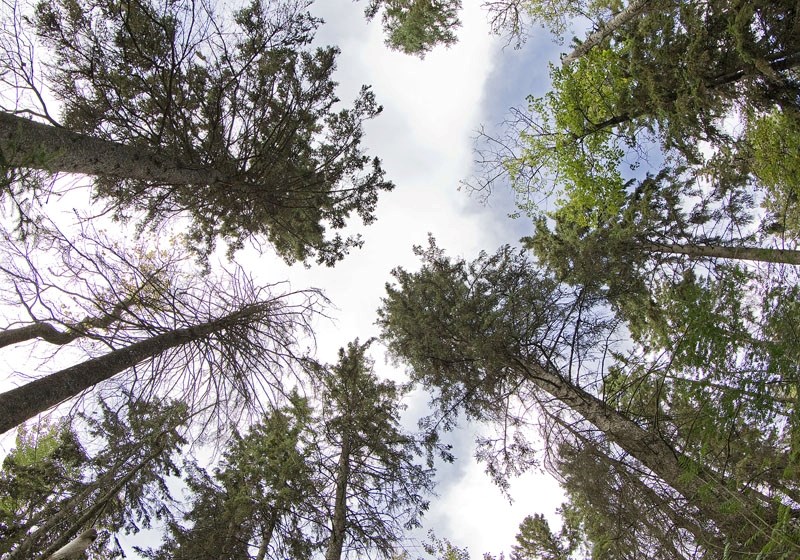It was a good day to be a tree on Monday as city council passed a slew of motions meant to recognize the importance of the local White Spruce Forest.
Council voted unanimously to make the White Spruce Forest a municipal historic resource at its regular meeting Monday. It also declared Sept. 18 to 24 to be National Forest Week in St. Albert, designated the American elm as the official deciduous tree of St. Albert, and heard a motion to spend $50,000 on enhancing the White Spruce Forest.
It was an appropriate time for these declarations, said retired forestry professor Peter Murphy, given that it's National Tree Day today. The White Spruce Forest is a living resource that has been with the city since the days of Father Albert Lacombe. "It's a part of our natural history, as well as our human history."
White Spruce Forest
The White Spruce Forest is a roughly 9.25-hectare tree stand next to Ray Gibbon Drive and the Sturgeon River. Research by Murphy, who lives in St. Albert, suggests it is about 170 years old.
White spruce is a native species that used to cover much of St. Albert, Murphy said. Settlers used it to build many of the first buildings in St. Albert, including the Father Lacombe Chapel. You can recognize it by its stiff, green, square-shaped needles.
This particular forest has also been threatened for years by developers and vandals. Council acquired the land from developers Genstar in late 2010 and announced that it would make it a municipal historic resource earlier this year.
The designation formally protects the forest from any future alteration or disturbance that is not authorized by council, explained Chris Jardine, the city's manager of community and protective services. "It's about saying, hey, this has meaning to us as a community, and we want to protect and preserve it as long as we can."
The city fenced off Hogan Road, which leads into the forest, years ago and stepped up its patrols to try and deter vandals, Jardine said. Now, it plans to appoint an expert committee to figure out how to develop the area and link it to Red Willow Park.
"The intent is to leave it as natural as possible," Jardine said. The forest would have trails, but they would probably not be asphalt ones like in the rest of Red Willow Park.
Coun. Len Bracko later moved to put $50,000 in the 2012 capital budget to spur development of the forest. "A number of people are ready to go and move forward on it," he said, and he wanted cash in place for them if they needed it. Council will vote on this and other capital items later this fall.
It's important to give people the chance to savour the forest, Murphy said, but they have to make sure it's safe to use, too. "I don't think we want to rush in and do anything." The area should have some trails, he said, as they would let people into the forest while keeping them away from sensitive areas.
The huge trees and thick canopy of the forest give it an almost spiritual quality, Murphy said. "There's something in there that's sensual or spiritual — a reverence for age and the complexity of the forest."
Local environmentalist Elke Blodgett said it was wonderful that the city had taken this step after years of pressure from the community. "I'm glad it got to this point."
American elm
Murphy was also part of the committee that picked the American elm as the city's official deciduous tree.
Back in 1966, a centennial committee recommended that the St. Albert adopt the Scots pine, highbush cranberry, petunia and Schubert chokecherry as its official coniferous tree, shrub, flower and deciduous tree. Council accepted three of the recommended plants this May, but rejected the chokecherry as it was vulnerable to black knot disease. The city asked the committee Murphy was on to pick an alternative deciduous tree.
The group settled on the elm because it's so prolific in St. Albert, Murphy said. "One of the first impressions I had [of St. Albert] was the quality of the streetscape with the elms." These giant trees are found throughout the city and create a canopy over many streets. You can recognize them by their umbrella-like shape and jagged leaves.
Murphy said the committee rejected the balsam poplar as too short-lived, the Manitoba maple as too aggressive, and the green ash as too vulnerable to bugs. American elms are vulnerable to Dutch elm disease, but that disease has yet to advance into Alberta, and there are extensive controls in place to stop its spread. "In the long run, I think elms are here to stay."
The committee also recommended making the white spruce the city's official coniferous tree instead of the Scots pine, as it was both native and historically significant. Council held off on that recommendation until they could contact members of the 1966 committee for their approval.




